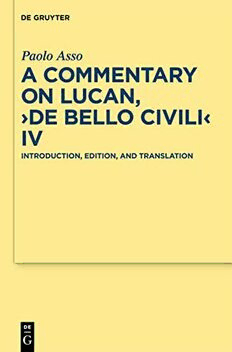
A Commentary on Lucan, "De bello civili" IV: Introduction, Edition, and Translation PDF
Preview A Commentary on Lucan, "De bello civili" IV: Introduction, Edition, and Translation
Paolo Asso ACommentary on Lucan, De bello civili IV TEXTE UND KOMMENTARE Eine altertumswissenschaftliche Reihe Herausgegeben von Siegmar Döpp, Adolf Köhnken, Ruth Scodel Band 33 De Gruyter A Commentary on Lucan, De bello civili IV Introduction, Edition, and Translation by Paolo Asso De Gruyter ISBN 978-3-11-020385-1 e-ISBN 978-3-11-021651-6 ISSN 0563-3087 Library of Congress Cataloging-in-Publication Data Asso, Paolo, 1965- A commentary on Lucan, "De bello civili IV" : introduction, edition, and translation / by Paolo Asso. p. cm. -- (Texte und Kommentare : eine altertumswissenschaftliche Reihe ; Bd. 33) Includes bibliographical references and index. ISBN 978-3-11-020385-1 (hardcover : alk. paper) 1. Lucan, 39-65. Pharsalia. Liber 4. 2. Rome--History--Civil War, 49-45 B.C.-- Literature and the war. 3. Epic poetry, Latin--History and criticism. 4. Caesar, Julius-- In literature. I. Lucan, 39-65. Pharsalia. Liber 4. English & Latin. II. Title. PA6480.A87 2009 873'.01--dc22 2009050252 Bibliographic information published by the Deutsche Nationalbibliothek The Deutsche Nationalbibliothek lists this publication in the Deutsche Nationalbibliografie; detailed bibliographic data are available in the Internet at http://dnb.d-nb.de. © 2010 Walter de Gruyter GmbH & Co. KG, Berlin/New York Typesetting: Michael Peschke, Berlin Printing: Hubert & Co. GmbH & Co. KG, Göttingen ∞Printed on acid-free paper Printed in Germany www.degruyter.com MATRI PATRIQVE AMATISSIMIS Table of Contents Acknowledgements...............................................................................IX Note to Readers......................................................................................X Introduction I. Lucan’s life and times: Vitae and other evidence.............................2 II. Lucan’s ‘antiphrastic’ epos.............................................................10 Book IV and its place in the poem.................................................14 III. Language and Style........................................................................18 Diction............................................................................................19 Syntax and word order....................................................................24 Rhetorical devices..........................................................................25 Meter..............................................................................................30 IV. Note on the Latin Text....................................................................33 Conspectus siglorum......................................................................36 Text and Translation.............................................................................38 Commentary Part I: The Battle of Ilerda 1–401.................................................100 1–23 Caesar’s arrival at Ilerda......................................................104 24–147 Skirmish at the Hillock and Caesarians in the Storm......116 148–253 Fraternizing....................................................................144 254–336 Pompeians in Trouble....................................................166 337–401 Pardon............................................................................181 Table of Contents VIII Part II: Mutual suicide: Volteius and the Opitergians 402–581.........189 Part III: Curio in Africa 581–824.......................................................213 581–8 From Vulteius’ aristeia in Illyricum to Curio’s arrival in Africa.....................................................213 4.589–660 Hercules and Antaeus.................................................220 4.661–714 Curio defeats Varus....................................................247 4.715–98 Curio and his army surprised and annihilated by King Juba.................................................265 4.799–824 The final apostrophe...................................................284 References and Abbreviations............................................................295 Index locorum notabiliorum potiorumque..........................................321 Index nominum et rerum....................................................................331 Acknowledgements Thanks are due to the institutions that supported my work: Princeton University, Swarthmore College, Kenyon College, the Università degli Studi di Napoli Federico II, and especially my home institution, the University of Michigan at Ann Arbor. Among all the individuals who offered their advice and feedback, I should mention Nicholas Horsfall and my mentors, Enrico Flores, Denis C. Feeney, Robert A. Kaster, and R. Elaine Fantham. Last and by no means least I want to express my heartfelt gratitude to my students Perot Bissel, Martin Halprin, Colin Keiffer, and Michael McOsker, and to my colleagues J. Mira Seo, Ruth Scodel, and Freder- ick F. Wherry. Note to Readers In referring to Lucan’s poem, whose title for us is Bellum Ciuile,1 the abbreviation BC is adopted. The text of Book IV has been established for the present edition on the basis of Housman 1927.2 In the lemmata and the Latin text there is no graphic distinction be- tween consonantal and vocalic u, but the remaining Latin quotations follow the practice adopted in the editions of the individual authors as reproduced in the Packard Humanities Institute database of Latin texts. The names and titles of works of ancient authors are abbreviated according to the Oxford Classical Dictionary (3rd ed., 1996), with occa- sional variations. Editions of fragmentary texts are identified by editor name following the fragment number. Works by modern authors, including translations as well as editions of fragmentary ancient texts, are cited by abbreviation. All abbreviated references and citations, including grammars, encyclopedias and lexica, are listed at the end in the comprehensive list ‘References and Abbre- viations.’ _____________ 1 On the poem’s title, see the remarks and the discussion cited in Shackleton Bailey 1988, iii. 2 See the ‘Note on the Latin Text’ on 33-5 below.
